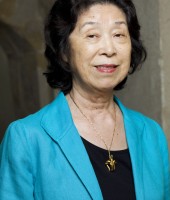Emiko Ohnuki Tierney
Emiko Ohnuki-Tierney is born and raised in Japan. After a B.A. degree from Tsuda College in Tokyo, she came to the United States on a Fulbright scholarship. Her anthropological work began with an anthropological history of the Detroit Chinese community since their arrival in the city (the only study of the "China Town," now demolished).
She then turned to the Sakhalin Ainu resettled in Hokkaido, resulting in three books. Realizing the limitation of studying a "memory culture," she shifted her focus on the Japanese, with Illness and Culture in Contemporary Japan as her first book on the Japanese. This work made her realize how one fails to understand the people and their way of life by studying only at a particular point in time. All her subsequent works have considered long periods of Japanese history to understand "culture through time." Her foci have been on various symbols of identities of the Japanese, such as rice and the monkey, within broader socio-political contexts and in comparative perspective. Her latest work began as a study of symbolism of cherry blossoms and their viewing in relation to Japanese identities. But she soon realized how the governments, since the end of the nineteenth century through World War II, manipulated cherished symbolism, such as that of cherry blossoms, and especially its folk aesthetic in order to co-opt people for their own purposes, such as waging wars and imperial expansions, without people realizing it. The work culminated in her two most recent books, with the last one, Kamikaze Diaries, introducing the diaries of student soldiers whom the government drafted and sent on the death mission known outside of Japan as "kamikaze." She continues to explore the general theories about the role of symbolism and folk aesthetic in historical and cross-cultural perspective and to show how the "culture concept" itself must be historicized, rather than thrown away altogether.
All her books have been re-written in Japanese for the Japanese readership. Her books have been translated into several languages, including Italian, Korean, Polish and Russian.
Son projet de recherche s'inscrit dans le cadre du programme collectif : "anthropologie d'hier à aujourd'hui" coordonné par Claude Imbert.
Be it in small scale societies or modern nation states, the taking of human lives—killing enemies as well as killing oneself—has almost always been aestheticized. In cultures ranging from the native peoples of South America, Papua New Guinea, North America, to the medieval Europe and the contemporary United States, “warriors” are highly decorated and military institutions are highly aestheticized. Among some so called tribal peoples, feathered headdresses, painted shields and cloaks, body painting, tattoos, and scarification, and a host of other techniques of beautification are used, while in modern armies uniforms are stylized and highly decorated with colorful insignias. The Japanese “samurai” sword is an aesthetic object par excellence, when it is also a most dangerous weapon for murder and suicide. The samurai armour (yoroi) is likewise an artistic object, just like most military uniforms are. Nitobe Inazō, who penned The Warrior’s Way: The Soul of Japan, in 1899, equated the warrior’s way with cherry blossoms in the opening sentence.
|
Communication d'E. Ohnuki-Tierney, résidente 2010 et 2016 de l'IEA de Paris Conférence d’E. Ohnuki-Tierney (résidente de l'IEA de Paris) |
|
|


